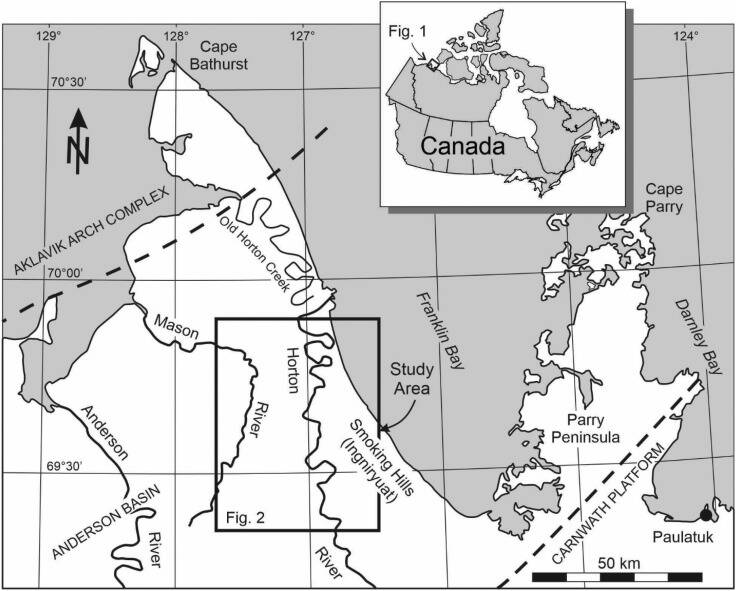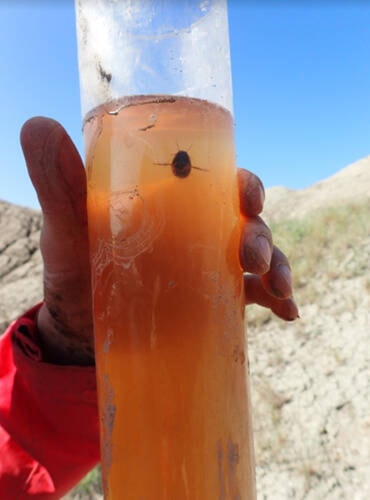At best, the surface of Mars is 54.6 million kilometers from the Arctic, but just to the west of Paulatuk a unique geological phenomenon is the latest front for the search for extraterrestrial life.
No aliens are present at the Smoking Hills, but Dr. Steve Grasby found something nearly as good — extensive jarosite deposits, a mineral that is being discovered in Martian rocks in droves.
“It gets very hot,” said Grasby, who last visited the site in 2018. “We tried to measure the temperature of the ground at one point — we actually just melted our thermometer.
“We found minerals that usually only form above about 1200 degrees Celsius.”
Finding jarosite on Earth is significant because the mineral only forms in highly acidic environments, which are usually not the places you would find life.
A current hypothesis of Martian geologic history argues the presence of jarosite means the oceans of Mars, which are believed to have disappeared some three billion years ago, were far too acidic for anything to live in. However, finding jarosite at the smoking hills instead suggests the Martian jarosite formed well after the oceans were gone, meaning Mars’ oceans could still have been teaming with life up until they disappeared.
Grasby pointed out the best option for scientists to study Mars are the rovers currently deployed there, which are fantastic pieces of technology but are no substitute for a properly equipped laboratory with human scientists. So it was important for researchers on Earth to study analogues to the red planet to help fill the knowledge gaps from the current technical limitations.
Known as Ingniryuat in Inuvialuit, the Smoking Hills are a one-of-a-kind area. Smoke billows out from the rock, filling the air and water with sulphuric acid and other hazardous chemicals. Grasby said the ground was so hot the team had to be careful to make sure their boots didn’t melt while they were at the site.
But while it looks like a volcano, it’s anything but. Grasby explained the Smoking Hills owe their uniqueness to an Arctic Ocean some 80 million years ago, when the Arctic was considerably warmer and dinosaurs patrolled the northern shores.
Even without plesiosaurs, the Arctic Ocean of the Cretaceous was very different from the Arctic Ocean of today. For one, the sea floor was anoxic — completely devoid of oxygen. This meant the normal decomposers who break down biological material from further up the water column weren’t around to do their job. Consequentially, biological material began to build up. Over time, this material was buried under rock, which pressed down on it enough to condense it into pyrite, or fool’s gold, and a coal-like substance called klinker. Inuvialuit traditional knowledge indicates people have been using the klinker from this area to fashion tools for thousands of years.
Klinker, like coal, is highly reactive, especially when wet. The heavy volumes of the stuff at the Smoking Hills, combined with sea water hitting the coastline, causes the klinker to oxidize. The heat from all the rock accumulates enough that combustion kicks in, resulting in the billowing smoke the area is known for.
Grasby added the area was home to some of the most acidic water found in nature. Only water deposits in old mines tend to get more acidic.
”And the water… it looks like a like a kind of Ruby coloured,” said Grasby. “It’d be like a nice red wine or something like that. But because there’s so metal rich, the the salts in the water is about three times the concentration of seawater.
“These ponds are just, you know, just pawns of toxic metals and this bright red water. So you just don’t even want that stuff touching you. You’ll burn your clothes if you got it on you.”
Noting scientists involved in the Mars rover project are excited about his findings, Grasby said he’s hoping to return to the Smoking Hills soon with similar instruments that are currently being deployed on Mars. His running hypothesis is the instruments should give the same results at the Smoking Hills that they’re giving on Mars, which should show the Martian jarosite likely formed in a life-friendly ocean.
”Our next step is talk to the communities,” he said. “We’ve already kind of reported on what we found before now we’re going to do just to see what their interests are and the ideas we have are of interest to them.
“If that all aligns and there’s agreement than we would like to try to look at getting back there and then next summer and to do some more work.”

